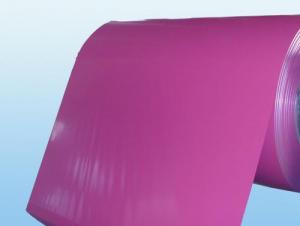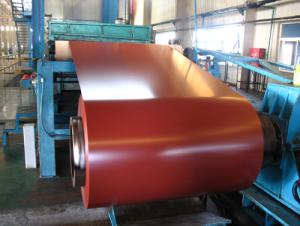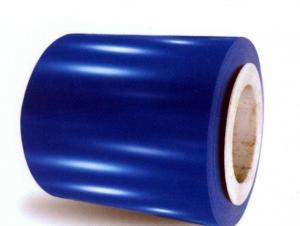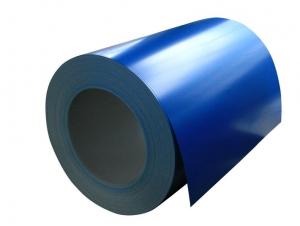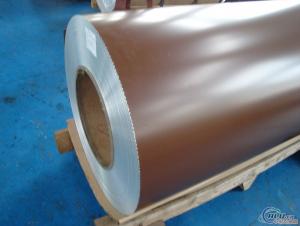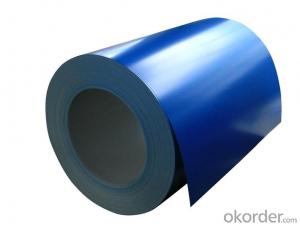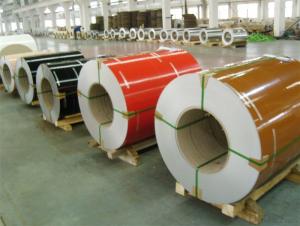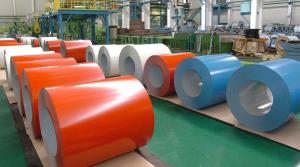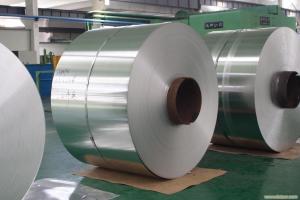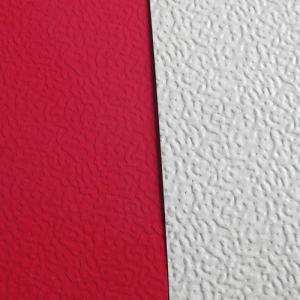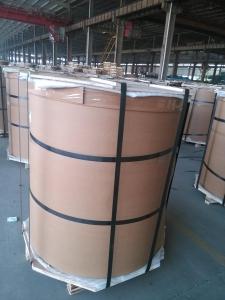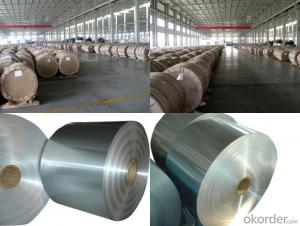Air Conditioner Aluminum Coil - Color Coated Aluminium Coil PE Painting AA3003 H14
- Loading Port:
- China Main Port
- Payment Terms:
- TT or LC
- Min Order Qty:
- -
- Supply Capability:
- -
OKorder Service Pledge
OKorder Financial Service
You Might Also Like
1.Structure of Product Description
Color Coated Aluminium Coil is widly used in decoration field. We can supply two kinds of paiting: PE and PVDF. For painting brand, we have China brand, PPGI and Becker.It depends our customers' requirement. PVDF coated aluminium coils are mainly used in the open air. It can last about 15-20 years. PE coated aluminium coils are used in the rooms, it can last 10 years.Now our Color coated aluminium coils are mainly exported to Asia, South America, Europe and so on.
2. Main features of the product
a.Exact Color--We have special color team to adjust the colors for our customers. You can provide our color sample or we can do color sample according to RAL Color System.
b.High quality-Our color coated aluminium coils are exported to Europe and pass European Standard Inspection.
c.Fast delivery time-The usual delivery time can be within 30 days.
3. Image


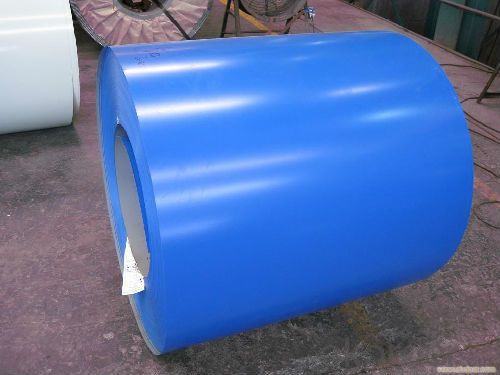
4. Product Specification
| Alloy | Temper | Color | Painting | Coating Thickness |
| AA3003 | H14 | RAL | PE&PVDF | 22-25micron |
5.FAQ
What is the quality standard?
---Usually our standard is GB3880-2006
What is the largest width?
---It is 2300mm
What is the MOQ?
---Usually we can accept 5 tons.
- Q: What is the tensile strength of aluminum coils?
- The specific alloy and temper employed can cause variations in the tensile strength of aluminum coils. On average, aluminum coils exhibit a tensile strength within the range of 150 to 300 megapascals (MPa). This implies that aluminum coils can endure a pulling force of 150 to 300 MPa without succumbing to breakage or deformation. It is noteworthy that the thickness of the coil, the manufacturing technique, and any supplementary treatments or coatings administered to the aluminum can potentially impact its tensile strength.
- Q: Can aluminum coils be used in aerospace applications?
- Yes, aluminum coils can be used in aerospace applications. Aluminum is a widely used material in the aerospace industry due to its lightweight and high strength-to-weight ratio. Aluminum coils are often used in the construction of aircraft structures, such as fuselages, wings, and landing gear, as well as in heat transfer and cooling systems. Their excellent corrosion resistance and high thermal conductivity make them suitable for various aerospace applications. Additionally, aluminum coils can be easily formed and fabricated, allowing for complex shapes and designs required in aerospace components.
- Q: How are aluminum coils protected against damage during handling?
- Aluminum coils are protected against damage during handling through various methods and precautions. Firstly, they are usually wrapped in a protective layer, such as plastic or paper, to provide a barrier against any physical contact or scratches. This protective wrapping also helps prevent moisture or dirt from coming into direct contact with the coils. Additionally, aluminum coils are often secured onto pallets or placed inside crates for added protection during transportation. These pallets or crates act as a buffer, absorbing any shocks or impacts that may occur during handling or shipping. This reduces the risk of dents, bends, or other forms of damage that could compromise the integrity of the coils. Furthermore, proper handling techniques are employed to ensure the coils are not mishandled or dropped. Forklifts or cranes are commonly used to lift and move the coils, minimizing the risk of human error or accidental damage caused by manual handling. Overall, a combination of protective wrapping, secure packaging, and careful handling practices are implemented to safeguard aluminum coils against potential damage during their transportation and handling processes.
- Q: Can aluminum coils be used in the production of aluminum doors?
- Yes, aluminum coils can be used in the production of aluminum doors. Aluminum coils are typically used as a raw material in the manufacturing process of aluminum doors. These coils are made from high-quality aluminum alloy and are available in various thicknesses and widths. They can be easily formed into different shapes and sizes to meet the specific requirements of the doors. Additionally, aluminum coils are lightweight, durable, and resistant to corrosion, making them an ideal choice for door production. The coils are often processed through various techniques such as cutting, bending, and welding to create the desired door components. Overall, aluminum coils offer many advantages in terms of versatility, strength, and aesthetics, making them a popular choice for aluminum door manufacturers.
- Q: What are the different color options for anodized aluminum coils?
- An extensive array of color choices is available when it comes to anodized aluminum coils. To create a protective oxide layer on the surface, the aluminum is immersed in an electrolyte solution and an electric current is applied during the anodization process. This oxide layer can be dyed in various colors, providing customization and aesthetic improvement. Anodized aluminum coils come in popular colors such as silver, black, bronze, gold, copper, and champagne. These colors are achieved by using different dye solutions during the anodization process. Moreover, each color category offers a variety of shades and finishes, giving more versatility and options. The color possibilities for anodized aluminum coils are not limited to solid colors alone. By employing masking techniques or advanced printing technologies, it is also possible to create patterns, gradients, and even custom designs. This grants even more freedom for creativity and the ability to match specific branding or design requirements. What's more, anodized aluminum coils possess excellent color retention and durability. The anodized oxide layer not only shields against corrosion and wear but also acts as a foundation for the dyed color, resulting in long-lasting and vibrant finishes. To summarize, the range of color options for anodized aluminum coils is vast and varied, encompassing traditional metallic finishes as well as bold and unique shades. This assortment ensures limitless possibilities in architectural, industrial, and decorative applications, guaranteeing a suitable color option for any project.
- Q: Can aluminum coils be used in the aerospace industry?
- Yes, aluminum coils can be used in the aerospace industry. Aluminum is widely used in the aerospace industry due to its desirable properties such as low density, high strength-to-weight ratio, and excellent corrosion resistance. Aluminum coils are often used in the manufacturing of various aircraft components such as fuselage panels, wings, and structural frameworks. The coils can be easily formed into different shapes and sizes, providing flexibility in design and reducing the overall weight of the aircraft. Additionally, aluminum coils are compatible with different manufacturing processes like welding, machining, and forming, making them an ideal choice for the aerospace industry.
- Q: Is it possible to create personal roofing material using aluminum coils?
- <p>Yes, you can use aluminum coils to make your own roofing material. Aluminum is a popular choice due to its durability, lightweight, and resistance to corrosion. To create roofing material, you would need to cut the coils to appropriate lengths, form them into panels, and possibly add protective coatings or finishes. However, this process requires specialized equipment and knowledge of roofing construction to ensure the material is safe, watertight, and structurally sound. It's also important to consider local building codes and regulations that may affect the suitability of homemade roofing materials.</p>
- Q: Today at my school I was messing with this sketch thingy, the one with 2 knobs to twist up or down to draw, my friend decided to break it and when we broke it, this silver dust called aluminum powder got on my hands, I never knew it was dangerous cause your see, we never read the manual we just found it. About 3 minutes later he pointed to my hand and I saw blood. It kinda stung.
- The aluminum powder found in an Etch-a-Sketch will not cut you, it's much too small. In fact it's so small you could only see it's edges under a high powered microscope. The cut was most likely caused by jagged glass/plastic when you broke the Etch-a-Sketch open. It's not unusual to cut yourself and not realize until someone else sees you're bleeding.
- Q: What are the environmental benefits of using aluminum coils?
- There are several environmental benefits of using aluminum coils. Firstly, aluminum is a highly sustainable material. It is one of the most abundant elements on Earth and can be easily extracted from bauxite ore. Unlike other metals, aluminum can be recycled indefinitely without losing its physical properties. This means that using aluminum coils helps reduce the demand for extracting new resources and minimizes the environmental impact of mining activities. Secondly, aluminum is lightweight, which makes it more energy-efficient during transportation. Its low weight reduces fuel consumption and greenhouse gas emissions associated with shipping and logistics. Additionally, aluminum coils can be easily formed and shaped, which allows for efficient packaging and reduces the need for excess materials. Furthermore, aluminum has excellent thermal conductivity properties. This means that aluminum coils can efficiently transfer heat, resulting in more energy-efficient heating and cooling systems. By using aluminum coils in HVAC systems or heat exchangers, energy consumption can be reduced, leading to lower carbon dioxide emissions and a smaller carbon footprint. Additionally, aluminum is highly resistant to corrosion and can withstand harsh weather conditions. This durability ensures a longer lifespan for aluminum coils, reducing the need for frequent replacements and minimizing waste generation. Lastly, aluminum is non-toxic and poses no threat to human health or the environment. It does not release harmful substances or pollutants during its production or use. This makes aluminum coils a safe and environmentally-friendly choice for various applications. In summary, the environmental benefits of using aluminum coils include its sustainability, recyclability, lightweight nature, energy efficiency, durability, and non-toxicity. By opting for aluminum coils, we can contribute to resource conservation, energy savings, and a healthier planet.
- Q: Can aluminum coils be used in the manufacturing of furniture?
- Indeed, furniture manufacturing can incorporate aluminum coils, which boast attributes of being both lightweight and durable. Consequently, this material is highly suitable for furniture production. Notably, it is frequently employed in the crafting of outdoor furniture due to its exceptional resistance against rust and corrosion. The malleability of aluminum coils permits the creation of furniture pieces in a diverse range of shapes and sizes. Furthermore, aluminum can be effortlessly tailored and adorned with a variety of coatings or paint, enabling it to harmonize with any desired aesthetic. In summary, opting for aluminum coils in furniture manufacturing proves to be a versatile and pragmatic decision.
Send your message to us
Air Conditioner Aluminum Coil - Color Coated Aluminium Coil PE Painting AA3003 H14
- Loading Port:
- China Main Port
- Payment Terms:
- TT or LC
- Min Order Qty:
- -
- Supply Capability:
- -
OKorder Service Pledge
OKorder Financial Service
Similar products
Hot products
Hot Searches
Related keywords
